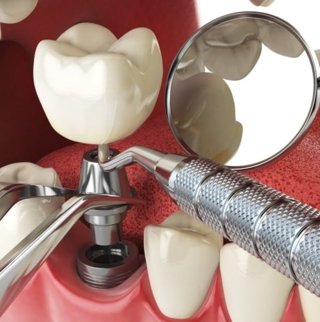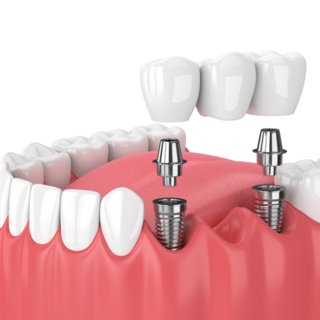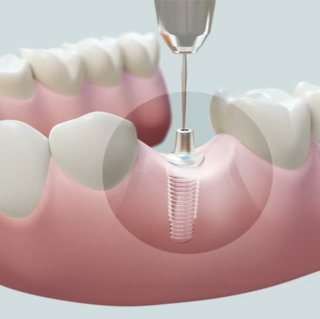
Dental Implant Overview
If you have one or more missing teeth, a dental implant can help you smile, talk and chew confidently again.
Who is this for
- Individuals who need replacement of a single tooth
- Patients who need replacement of several teeth with an implant-supported bridge or single crowns
- Patients who need to replace a complete denture with a bridge supported on several implants
- Individuals with sufficient bone density and volume in the jaw (otherwise bone grafting may be a viable solution)
Treatment abroad
- Minimum stay: First visit 1 - 2 days, Second visit 3 - 7 days
- Number of trips: 2
Treatment process
- Step 1: Your implant placement will take 1 to 2 hours.
- Step 2: You will wait 2 months in average for your osseointegration.
- Step 3: The dentist will prepare your custom-made crowns, which may take 3 to 7 days. Once ready, crowns will be placed in 1 to 2 hours.
- You may require additional time if you need bone grafting.
- Short-term: one week for implant site and gums to heal
- Long-term: healing time after implant session takes 4 to 6 months
Implant Treatment Cost
Implant Type
Brand Origin
Price
BEGO Semados®
Implant & Abutment
German
€400
Straumann® Zinedent
Implant & Abutment
Swiss
€400
Implant Treatment Cost
Implant Type
Price
BEGO Semados®
Implant & Abutment
€400
Straumann® Zinedent
Implant & Abutment
€400
Zirconia Crown
€160
Full Ceramic Crown
€300
Ceramic-Metal Crown
€120
Dental Implant Process
How does it work?
Dental implants can be made of titanium or zirconia. An implant is comprised of three parts: the implant device itself that serves as substitute for the tooth root, the overlying crown or denture, and the abutment, which connects the implant device to the crown, bridge, or denture. Once the abutment is screwed into the implant, and the tissue sutured, it is left to heal and become stable. The implant gets fused to the jawbone after a period of average 4 months.
What does a dental implant procedure involve?
The timing of the dental implants procedure, and the number of visits required, is largely dependent on each individual, specifically on how quickly the implanted tooth and surrounding area heals and if the patient needs bone grafting. When bone grafting is not required, the complete procedure (from the consultation visit to the last one, where the permanent crown is placed) can take average 4 months.
Below are the 6 steps that must occur in order to get a dental implant:
- Treatment plan: In order to determine the best treatment plan for each individual's needs, the oral surgeon will need an updated x-ray of the patient's mouth. The surgeon will then be able to evaluate the health of the teeth and determine if teeth extraction, bone grafting, or sinus lifting will be needed for the dental implant. During the first personal consultation, the dentist might also order additional examinations or request a CT scan to check bone mass.
- Bone grafting (when necessary): If the natural bone is not sufficient, bone grafting may be necessary. A bone graft involves the placement of either natural or synthetic bone material so that the implant will be stable and secure. Depending on the quantity of additional bone mass necessary, a bone graft can be performed at the same time as implant surgery or in a separate session.
- Implantation: The surgery time depends on the number of implants needed and the overall health of the patient's mouth. Depending on the complexity of the procedure, surgery can last anywhere from less than an hour to up to 6 hours. The procedure occurs under local anesthesia and is the same regardless of how many implants are necessary. The gum tissue is opened to expose the bone area where the implant will be placed. Once the jawbone is exposed, the dentist will use a special drill to create the space for the implant in the bone. The implant is then placed into the jawbone and the gums are stitched closed over the implant. Your surgeon will place a temporary crown or retainer to fill the hole created.
- Healing: Osseointegration, the process in which the implant becomes a part of the jaw, takes about average 4 months to complete. This is usually referred to as the healing period.
- Final restoration: When the gum tissue is fully healed and ready, it is re-exposed to attach the abutment to the implant. This process can take anywhere from 3 to 7 days. Once the custom-made crown is ready, it is placed over the abutment, and the final prosthetic crown appears as a natural tooth.
- After care: Some small bruises and swelling in the gum may occur right after surgery. Patients should avoid smoking and eating solid food until the gums are healed. The long-term success of an implant requires oral hygiene. It is paramount to keep implants, artificial teeth, and gum tissue clean, just like natural teeth. Moreover, it is advised to do regular checkups to check oral hygiene, and the function and stability of the implant.
What types of dental implant are there?
Bego: The implants from Bego are made from purely neutral titanium, ensuring the highest level of compatibility with the human body. The shape is specially designed to ensure perfect fixing after restoration.
Straumann Zinedent: Zinedent implants are designed for immediate restoration and are made of titanium.
What should I expect from a dental implant procedure?
- After implant session
After the implant session - that is when the implant is inserted into your jawbone - you might feel discomfort or pain once the anaesthesia has worn off. Moreover, some small bruises and swelling in the gum may occur. You may be restricted to a soft-food diet for the healing time. Healing time after this procedure is 4 months in average.
- After the following sessions
Once your healing time is complete, the following sessions will involve taking impressions of your teeth, creating custom-made crowns for your implants and doing some tests to see if the crowns fit and feel good in your mouth. Then, the crown will be sealed to your implant. You can go back to your routine activities right after.
- Once treatment is complete (4 to 6 months after implantation)
- You will feel more comfortable smiling, eating, and talking: since crowns are made to match natural teeth, their color, shape will look like a natural, integral part of the mouth.
- Your jawbones will get stronger: dental implants stimulate the growth of the jawbone during the process of osseointegration, making the area stronger and healthier.
- You should take good care of your dental hygiene: unlike movable dentures, dental implants are stable and fixed to the jawbone, and with proper oral hygiene, they are a durable and long-lasting solution.
DENTAL IMPLANT GALLERY
Dental implant process images
After Care
What is the aftercare for a dental implant procedure?
- Swelling can be managed by applying ice packs to the surgical site. This needs to be done continuously for at least the first 36 hours.
- Bleeding is common after an endosseous implant aka dental implant procedure. If it is in excess, you can place a sterile gauze piece in between your teeth for about 30 minutes. If the bleeding doesn't stop, you will have to consult your doctor.
- Aftercare pain medication and antibiotics need to be taken as per your doctor's after care instructions.
- Keep all physical activity including strenuous exercise to a minimum, as this can increase bleeding.
- Dentures and prosthesis that a patient has been putting in the mouth since before the implants were in place, need to be avoided for at least 10 days post surgery. Using the dentures can lead to application of pressure on the new implants, before they have completely healed.
What is the diet for a dental implant procedure?
- Opt for liquids and pureed food for the first few days after your procedure.
- Over the next few weeks, transition to solid food. It is advisable not to skip any meals.
- Avoid food that is really hot, as it will take a few days for the sensation in your tongue to return.
- Oral hygiene needs to be maintained after the procedure. This includes brushing and rinsing at least twice a day.
Dental Implant FAQ
What is bone grafting?
Bone grafting is the placement of synthetic bone material to an area where natural bone is not sufficient. Bone grafting will require additional time before the actual dental implant procedure can start as it can take up to several months for the graft to create new, strong bone. When only a minor bone graft is needed, you might be able to have the procedure at the same time as the implant surgery. A panoramic dental x-ray and a CT scan will help check the amount of bone available to determine whether bone grafting is necessary for the implant placement.
In combination with bone grafting, a sinus lift may be required: when the bone is added between your upper jaw and the maxillary sinuses (one of the sinuses located near the nose), the sinus membrane needs to be moved upward (or "lifted") to make room for the bone.
Who is not eligible for dental implants?
Dental implants are usually not recommended for:
- Patients who present symptoms of advanced gum disease or periodontal disease.
- Patients who are taking steroids, are undergoing chemotherapy or radiation treatments, who have diabetes, uncontrolled coagulation disorders, osteoporosis, or a weakened immune system.
- Individuals who present serious tooth decay should take corrective measures beforehand.
Potential risks and side effects
- Success rate is up to 98%
- Dental implants last for about 40 years. On an average, the success rate for a dental implant is 95% in about 50 years of use.
- Cases of failure are rare. These mostly happen because of allergy from the metal used in the implant.
Alternative treatments
Plan your treatment and get a quote online.
30 minutes free online video and phone consultation. Schedule your virtual visit.










